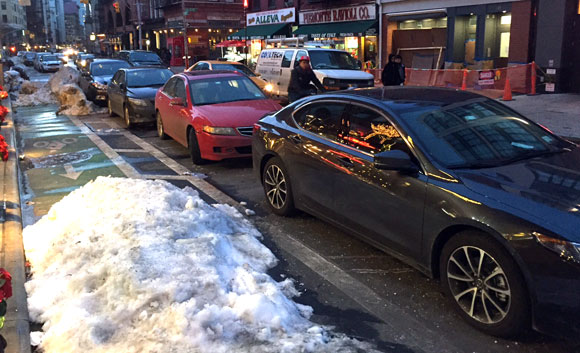Here we are a whole work week after Winter Storm Jonas dumped two feet of snow on New York, and the streets are still not passable for a lot of New Yorkers who get around without driving.
In the beginning of the week, the biggest travesties were the snow barriers at street corners and the uncleared bus stops that compelled people to wait in the street. Today, the worst accumulation seems to be in the city's protected bike lanes and greenways.
These are supposed to be transportation arteries that give people a refuge from biking next to motorized traffic, but a lot of them are still barricaded by snow and next to useless. Without some action from the Department of Sanitation, we'll be lucky if the rain melts the stuff away and the city loses no more than a week of useful bikeway time.
It doesn't have to be this way. There's always going to be some level of inconvenience after a big NYC snowstorm, but there's no reason it should be this wretched or last this long.
In his assessment of the post-Jonas streetscape, Justin Davidson at New York Mag pointed to Montreal as a city that's mastered the science of snow clearance. City Hall should send a fact-finding crew across the border and bring back lessons for the next big storm.
Not that we need to venture far afield to figure out what needs to improve. Here are three suggestions that would make a big difference for walking, biking, and riding the bus after a snowstorm. This is by no means a comprehensive list -- it's just the obvious stuff.
Make someone responsible for clearing paths at street corners. Currently, property owners are legally responsible for clearing the sidewalk in front of their buildings, but when you cross the street you enter a no man's land where the law doesn't apply. Hence the snow piles, reinforced by passing plows, that block the way at street corners. Corner property owners should be responsible for this area too, and the city could start by setting a better example at buildings it owns, like schools. In areas with lots of foot traffic, the Department of Sanitation should dispatch more workers to clear these problem spots (also see "snowblowers" below).
Integrate bike lanes, especially protected bike lanes, into the city's snow clearance street hierarchy. The Department of Sanitation has a system to prioritize snow clearance on the city's 6,000 miles of streets, with bus routes and highly trafficked streets getting plowed before low-traffic, residential streets. Apparently, all bike lanes fall entirely outside this hierarchy, with the department telling DNAinfo that bikeways get cleared after everything else. But protected bike lanes, especially, should be a priority -- they are major through routes for bike traffic and perform a crucial public safety function. Letting snow pile up and block bike lanes degrades the transportation network for significant chunks of time.
Buy some snowblowers. Sanitation hired 920 laborers to clear snow from sidewalks and bus stops with shovels. Imagine how much faster they could clear pedestrian areas, not to mention how much easier it would be on their backs, if they were equipped with snowblowers instead.






